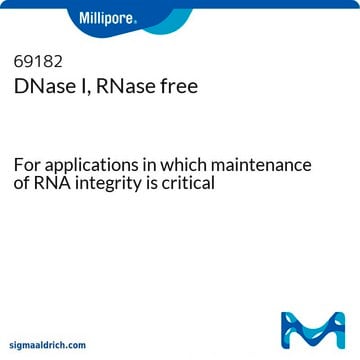04716728001
Roche
DNase I recombinant, RNase-free
from bovine pancreas, expressed in Pichia pastoris
About This Item
Recommended Products
biological source
bovine pancreas
Quality Level
recombinant
expressed in Pichia pastoris
form
solution
mol wt
~39 kDa
packaging
pkg of 10,000 U
manufacturer/tradename
Roche
optimum pH
7.0-8.0
General description
Contents
- Recombinant DNase I, RNase-free, 10 U/μl
- Incubation Buffer, 10x concentrated
Specificity
Important Note: Alternatively, DNase I recombinant, RNase-free can be inactivated and removed by phenol extraction according to standard protocols, e.g., Current Protocols in Molecular Biology.
Application
- Remove genomic DNA from RNA preparations prior to RT-PCR
- Isolate DNA-free RNA after in vitro transcription reactions
- Perform nick translations
- Map DNase-sensitive regions in eukaryotic DNA
Features and Benefits
- Eliminates DNA contamination from any RNA sample
- Contains no detectable RNase or protease activity
- Can be heat inactivated, thereby eliminating the need for organic extraction
- Shipped with an optimized incubation buffer, which supports maximum DNase activity
- Produced via an entirely animal-free process, to eliminate any risks associated with animal-derived material
Packaging
Quality
Specifications
Recombinant DNase I is heterogeneously N-glycosylated, so it appears as two bands in gel electrophoresis.
Divalent ion requirement
DNase I requires divalent cations for maximum activity. The DNA-specific endonuclease is activated by ions such as magnesium ions and is stimulated by calcium ions. Therefore, the enzyme is inhibited by metal chelating agents like EDTA.
Unit Definition
Assay conditions:
Volume activity is determined according to the following assay mixture. 100 μg calf thymus DNA is incubated in 2.5 ml 1x incubation buffer with 40 to 70 units DNase I recombinant, RNase-free at +25 °C. The absorbance increase is measured at 260 nm.
Preparation Note
Working solution: Storage Buffer: 20 mM Tris-HCl, 50 mM NaCl, 2 mM CaCl2, 2 mM MgCl2, 1 mM dithioerythritol, 0.1 mg/ml Pefabloc SC, 50% glycerol (v/v), pH 7.6 (at 4 °C).
Incubation Buffer (10x): 400 mM Tris-HCl, 100 mM NaCl, 60 mM MgCl2, 10 mM CaCl2, pH 7.9.
Enzyme Dilution Buffer: 25 mM Tris-HCl, 50% glycerol (v/v), pH 7.6 (at 4 °C).
Storage and Stability
Other Notes
Storage Class Code
12 - Non Combustible Liquids
WGK
WGK 1
Flash Point(F)
does not flash
Flash Point(C)
does not flash
Choose from one of the most recent versions:
Already Own This Product?
Find documentation for the products that you have recently purchased in the Document Library.
Customers Also Viewed
Articles
Organoid culture products to generate tissue and stem cell derived 3D brain, intestinal, gut, lung and cancer tumor organoid models.
Organoid culture products to generate tissue and stem cell derived 3D brain, intestinal, gut, lung and cancer tumor organoid models.
Organoid culture products to generate tissue and stem cell derived 3D brain, intestinal, gut, lung and cancer tumor organoid models.
Organoid culture products to generate tissue and stem cell derived 3D brain, intestinal, gut, lung and cancer tumor organoid models.
Protocols
DNase I from bovine pancreas is a glycoprotein of Mr 37000. A special procedure is used to remove RNases from the DNase preparation.
Our team of scientists has experience in all areas of research including Life Science, Material Science, Chemical Synthesis, Chromatography, Analytical and many others.
Contact Technical Service










